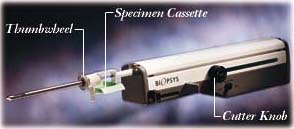The entire procedure looks like this: First, the skin of the breast is cleaned. Then, a small amount of local anesthetic (lidocaine), similar to what one might have at a dentist’s office, is injected into the skin and deeper tissues of the breast using a small hypodermic needle. Under stereotactic or ultrasound guidance, the radiologist or breast surgeon positions the special breast probe into the area of the breast where the lesion (abnormality) is located. Afer the probe has been properly positioned, a vacuum line draws the breast tissue through the aperture of the probe into the sampling chamber of the device. Once the tissue is in the sampling chamber, the rotating cutting device is advanced and a tissue sample is captured. The tissue sample is then carried through the probe to the tissue collection area (a standard pathology tissue cassette). After a tissue sample is captured, the radiologist or surgeon then rotates the thumbwheel of the probe, moving the sampling chamber approximately 30 degrees to new position. The entire cycle is repeated, until all desired areas have been sampled (typically, eight to 10 samples of breast tissue are taken 360 degrees around the lesion). When a sufficient number of tissue samples have been collected, the radiologist or surgeon will remove the probe and apply pressure to the biopsy site. An adhesive bandage will be applied to the skin nick. In some cases, a small sterile clip will be placed into the biopsy site of the breast to mark the location in case a future biopsy is needed. This microclip is left inside the breast and causes no pain, disfigurement, or harm to the patient. After the biopsy is complete, the tissue samples will be sent to the pathology laboratory for diagnosis.
This is what the instrument looks like:

The surgeon tried to reassure me by telling me that 80% of biopsies result in a benign diagnosis. To that, I replied, "Have we met? I always fall into that small percentage!" He just smiled and told me not to jump the gun. This is so emotionally exhausting! When will they learn to listen to me?



Starting over having to kick the ass of the same crap all the time is exhausting. The entire thing sucks. But I am excited to hear how your interview goes tomorrow!
ReplyDeleteYou have my prayers. But for a physician to really listen?? What planet are you on?? I know they think my back pain is elusive and I should be magically healed by now... I belong to that small unfortunate percentage as well. I miss you Tami!
ReplyDelete